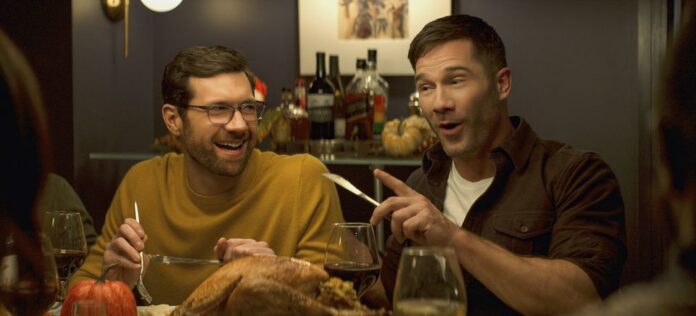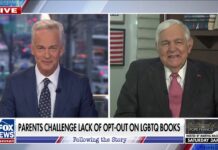Advertisement
Finally, gays experienced big-screen romantic kisses that were not intended to shock audiences but instead to show that they fell in love, just like everyone else. When Christopher Reeve, Superman himself, locked lips with Michael Caine in 1982′s “Deathtrap,” it felt as if a seismic shift was occurring.
These advances look downright anemic compared to “Bros,” Billy Eichner’s “boy meets bro love story” that opens with an all-star, all-LGBT+ principal cast Sept. 30. The film is notable for being the first big-budget gay rom-com given a theatrical release by a major studio. It’s also the first major studio film to be written by and star an openly gay man.

But 40 years ago, the gay films of 1982 were a sensation and a carefully analyzed trend. Siskel and cohost Roger Ebert devoted an episode of their syndicated “At the Movies” TV show to “Changing Attitudes Toward Homosexuality,” based on the films of 1982.
In a single year, major Hollywood studios released “Making Love,” “Personal Best,” “Deathtrap,” “Victor/Victoria,” and, to the delight of no one, “Partners.” In The New York Times, Karen Stabiner wrote, “Major film studios made a hedged bet this season that the healthy, wealthy and-or wise homosexual was a marketable commodity.”
Advertisement

It turns out they were, and audiences for the films consisted of more than LGBTQ+ movie buffs. “Victor/Victoria,” with the bankable star power of Julie Andrews as a woman who pretends to be a man pretending to be a “female illusionist,” was a hit. It wasn’t exactly a gay film. The central love story was focused on Andrews and James Garner. But one of the film’s subplots showed two men (one of them a former NFL star) falling in love. It was all played to comedic effect, but the farcical musical was a hit, and despite ever-present gay slurs, it had a big heart.
Audiences were not as prepared to accept the romance in “Making Love.” Successful, dashing oncologist Zack Elliott (Michael Ontkean) and his network executive wife, Claire (Kate Jackson), are the perfect couple, which means that there are definitely underlying issues. The issue here is a doozy. Zack is gay, and he bursts out of the closet by falling hard for a commitment-averse gay novelist played by Harry Hamlin. In the process, he leaves his wife and their collection of Gilbert and Sullivan records behind.

The film’s trailer starts with a disclaimer: “20th Century Fox presents one of the most honest and controversial films we’ve ever released. ‘Making Love’ deals openly and candidly with a delicate issue. It is not sexually explicit, but it may be too much for some people.”
Advertisement
“Too much for some people” means that Ontkean and Hamlin kiss. Like, really kiss. And then they tastefully roll around in bed without shirts. It’s a movie that Hamlin later said ended his film career, although four years later, he found success on television on “LA Law.”
Despite a strong opening weekend, the movie was deemed a flop. Watching it in 2022, “Making Love” feels more ham-fisted than shocking. The characters switch from content to furious with just a glance or a word. But at the core of it, there’s a love story between Ontkean and Hamlin, and neither of them commits suicide or gets shot. It was a solid start.
Also solid was “Personal Best,” another love story, this time between two women who are competing to qualify for the 1980 US Olympic track and field team. While the same-sex romance in “Making Love” always felt fraught and antagonistic, the connection between Chris Cahill (Mariel Hemingway) and Tory Skinner (Patrice Donnelly) flows naturally with the story. They kiss, flirt, and eventually fall in love. Thankfully Warner Bros. didn’t feel the need to warn audiences about lesbian romance in the movie’s trailer.

Good reviews didn’t help “Personal Best.” It still ended up losing money. Apparently, America wasn’t ready for a gay love story, unless it involved Julie Andrews in drag.
While “Making Love” and “Personal Best” showed LGBTQ+ characters in groundbreaking new ways, “Partners” set the clock back 10 years by dragging out wince-inducing stereotypes of gay men as flouncy, predatory, and useless — unless you needed a sniveling queen to whip up a crème brûlée in a pinch. It’s a buddy comedy with a straight cop and a gay cop. The very straight Sergeant Benson (Ryan O’Neal) and the hesitantly gay Officer Kerwin (John Hurt) are paired to solve a series of murders in Los Angeles’s gay community.
Advertisement

Poor Hurt, who had won BAFTAs and Golden Globes, was given a quivering character who spent the film looking doe-eyed at his straight colleague, while O’Neal’s Sergeant Benson was a golden slice of heterosexual beefcake. “Partners” would imply these two were equal in the relationship. A more accurate title would have been “The Stag and the Fag.”

It was also the year of “The World According to Garp,” which featured John Lithgow playing a trans character, and “Tootsie,” where Dustin Hoffman put on a dress to get a job. But the glow, no matter how uneven, of 1982 was quickly dimmed. The era of the homosexual as a marketable commodity disappeared as quickly as it had arrived. In 1982, AIDS entered the picture, and Hollywood ran. The freewheeling 1970s (when many of the 1982 film projects were written or conceived) fully slipped into the morally upright 1980s, and the bankability of LGBTQ+ movies had proven too erratic.
But for one brief year, Hollywood had seen the LGBTQ+ community as both subject and consumer. Finally, there were films where at least a few queer characters found their happily ever after.
Advertisement
Christopher Muther can be reached at christopher.muther@globe.com. Follow him on Twitter @Chris_Muther and Instagram @chris_muther.








